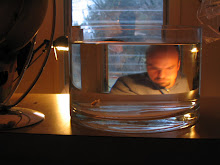
Hugo Ball recommended cutting out words from the day's paper, placing them in a bag, drawing them at random, and setting them down into a poem that lay beyond one's control. Arp dropped cut-out forms on a ground, and affixed them; Duchamp dropped a one-meter-long string onto a surface and adopted the resulting serpentine form as a template.
On Sabina Avenue, our methods for generating chaos are simpler still. We lower Cleo into her shallow, battery-operated jiggle chair, place it on the picnic table, and watch her go. Just follow her right hand for a minute, and you'll see what seems like pure chaos. It's at her ear; it's at her side; it's clutching her blanket; it's twisting in space.
And yet it seems too easy to call the movements purely random. Is there a system, an aesthetic, a motivation behind them? Today I imagined that I was watching the formation, as she moved, of a crazed skein of neurons that will govern future motions. But I also thought, in turn, of the 1948 Soviet critic who saw the atonal compositions of Schonberg as "confused, neuropathological combinations that transform music into cacophony, into a chaotic conglomerations of sounds." Is it necessary to point out that in time, listeners found an order in Schonberg, as well?
Pure chaos is remarkably hard, it turns out, to generate. And beneath it often lies a larger order.
On Sabina Avenue, our methods for generating chaos are simpler still. We lower Cleo into her shallow, battery-operated jiggle chair, place it on the picnic table, and watch her go. Just follow her right hand for a minute, and you'll see what seems like pure chaos. It's at her ear; it's at her side; it's clutching her blanket; it's twisting in space.
And yet it seems too easy to call the movements purely random. Is there a system, an aesthetic, a motivation behind them? Today I imagined that I was watching the formation, as she moved, of a crazed skein of neurons that will govern future motions. But I also thought, in turn, of the 1948 Soviet critic who saw the atonal compositions of Schonberg as "confused, neuropathological combinations that transform music into cacophony, into a chaotic conglomerations of sounds." Is it necessary to point out that in time, listeners found an order in Schonberg, as well?
Pure chaos is remarkably hard, it turns out, to generate. And beneath it often lies a larger order.




No comments:
Post a Comment